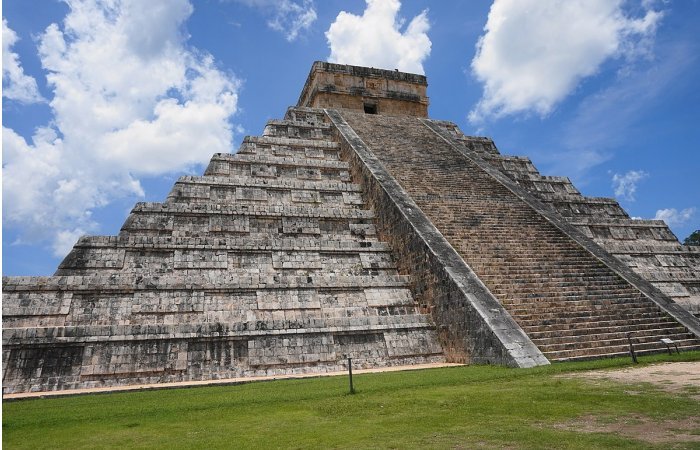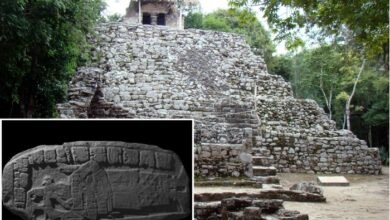More Than Drought Behind Ancient Maya Civilization’s Collapse

Conny Waters – AncientPages.com – Between 750 and 900 CE, the Maya lowlands in Central America underwent a significant demographic and political decline. Scientific studies have long linked this collapse to repeated episodes of intense drought during that period. For many years, the prevailing theory was that the climate crisis played a central role in the downfall of the Maya civilization.
Mayan Temple in Chichen Itza. Credit: Scratchbotox – CC BY-SA 4.0
However, recent analysis of sediment samples dating back 3,300 years offers new insights that partially challenge this established view. Benjamin Gwinneth, a geography professor at Université de Montréal and an expert on environmental change affecting Maya civilization, has conducted extensive research at the Itzan site in present-day Guatemala.
What Happened?
By examining core samples from sediments collected at Laguna Itzan—a lake near the archaeological site—Gwinneth and his team are reconstructing both human activity and climatic conditions over time. Their work is helping to build a more nuanced understanding of how environmental factors may have influenced historical events in the region.
No evidence of drought has been found in the region. However, the Maya population declined simultaneously with areas in Guatemala and Mexico that did experience drought conditions.
So what happened?
Gwinneth and his team analyzed three key geochemical indicators in the Itzan lakebed sediment to gain insights into past environmental and human activity. Polycyclic aromatic hydrocarbons were measured to assess the intensity of slash-and-burn fires, while leaf waxes provided information about vegetation types and precipitation patterns. Additionally, fecal stanols served as a proxy for estimating population density.
By examining these indicators together, the researchers were able to reconstruct changes in population size, agricultural practices, and climate from the earliest evidence of human presence around Laguna Itzan 4,000 years ago up until its abandonment approximately 1,000 years ago.
“The data revealed that the first permanent settlements appeared 3,200 years ago,” said Gwinneth in a press release. “There were slash-and-burn fires and an increase in population. During the Preclassic period, between 3,500 and 2,000 years ago, the Maya used fire extensively. They practiced slash-and-burn agriculture, using fire to clear the forest and then growing crops on the fertile ashes.”
New Farming Practices
A radical change occurred during the Classic period, between 1,600 and 1,000 years ago: although populations were much denser, the use of fire decreased considerably. “This probably means that most of the land had been cleared, which could have led to a change in agricultural strategy,” said Gwinneth.
The data suggest a major intensification of agriculture, including ridge and furrow ploughing to reduce erosion and intensive gardening. “Fire was no longer an important component of their farming practices,” Gwinneth said. “This transformation reflects gradual urbanization and suggests that the Maya were changing agricultural strategies to feed a growing population.”
This change in agricultural practices is consistent with what archaeologists and anthropologists know about the Maya civilization at its peak: it was a complex, urbanized society with increasing specialization and advanced agricultural techniques adapted to the environment.
The Stable Climate Riddle
However, analysis of hydrogen isotopes has shown that, unlike Maya sites further north that suffered drought, Itzan seems to have had a stable climate due to its geography.
“Itzan is located near the Cordillera, where atmospheric currents from the Caribbean generate regular orographic (mountain-related) rainfall,” Gwinneth explained. “While other Maya regions suffered devastating droughts, Itzan appeared to have a stable climate.”
Gwinneth considers this discovery significant because some archaeologists have argued that the Maya collapse began in the southwestern region, where Itzan is located. If Itzan did not experience drought, this can’t have been the initial cause of the decline, he said.
“Even though there were no drought conditions locally, the population of Itzan declined sharply during the Terminal Classic period, between 1,140 and 1,000 years ago,” Gwinneth continued. “Population markers show a dramatic fall, signs of agriculture disappear, the site was abandoned.”
How can we explain that a community with water and favourable conditions suffered the same fate as its neighbours, who were afflicted by drought?
Fatal Interdependence
“The answer lies in the interconnectedness of Maya societies,” said Gwinneth. “The cities did not exist in isolation; they formed a complex network of trading relationships, political alliances, and economic dependence.
“When the central lowlands were hit by drought, this may have triggered a cascading series of crises: wars between cities over resources, the collapse of royal dynasties, mass migrations, disruption of trade routes, and so on.”
Sampling of tree leaves in northern Guatemala. Credit: Jonathan Obrist Farner
According to this theory, Itzan’s decline was not due to a shortage of water, but rather to its entanglement in the upheaval that followed the collapse of the broader system it belonged to. The interconnectedness of Maya cities meant that a drought in one area could trigger widespread disruption. Even if drought conditions were localized, their effects rippled outward, leading to a domino effect that contributed to the collapse of cities throughout the region.
“The transformation or “collapse” of the Maya civilization was not a mechanical result of a uniform climate catastrophe; it was a complex phenomenon in which climate, social organization, economic networks and political dynamics were intertwined,” Gwinneth concluded.
See also: More Archaeology News
“Regional socio-political and economic factors played a decisive role.”
Gwinneth considers these findings significant for our current era, as they offer valuable insights into how civilizations adapt to environmental changes. This perspective can help us better understand the challenges we face today and inform our responses to ongoing environmental shifts.
Written by Conny Waters – AncientPages.com Staff Writer






